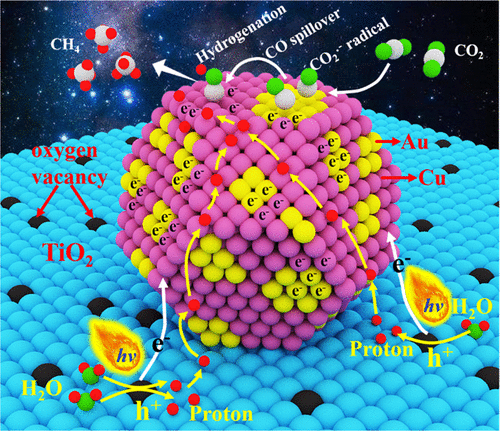当前位置:
X-MOL 学术
›
ACS Appl. Mater. Interfaces
›
论文详情
Our official English website, www.x-mol.net, welcomes your
feedback! (Note: you will need to create a separate account there.)
Synergistic Integration of AuCu Co-Catalyst with Oxygen Vacancies on TiO2 for Efficient Photocatalytic Conversion of CO2 to CH4
ACS Applied Materials & Interfaces ( IF 8.3 ) Pub Date : 2021-09-24 , DOI: 10.1021/acsami.1c14371 Deli Jiang 1 , Yimeng Zhou 1 , Qianxiao Zhang 1 , Qi Song 1 , Changjian Zhou 2 , Xiangli Shi 2 , Di Li 2
ACS Applied Materials & Interfaces ( IF 8.3 ) Pub Date : 2021-09-24 , DOI: 10.1021/acsami.1c14371 Deli Jiang 1 , Yimeng Zhou 1 , Qianxiao Zhang 1 , Qi Song 1 , Changjian Zhou 2 , Xiangli Shi 2 , Di Li 2
Affiliation

|
Photocatalytic reduction of CO2 toward eight-electron CH4 product with simultaneously high conversion efficiency and selectivity remains great challenging owing to the sluggish charge separation and transfer kinetics and lack of active sites for the adsorption and activation of reactants. Herein, a defective TiO2 nanosheet photocatalyst simultaneously equipped with AuCu alloy co-catalyst and oxygen vacancies (AuCu-TiO2–x NSs) was rationally designed and fabricated for the selective conversion of CO2 into CH4. The experimental results demonstrated that the AuCu alloy co-catalyst not only effectively promotes the separation of photogenerated electron–hole pairs but also acts as synergistic active sites for the reduction of CO2. The oxygen vacancies in TiO2 contribute to the separation of charge carriers and, more importantly, promote the oxidation of H2O, thus providing rich protons to promote the deep reduction of CO2 to CH4. Consequently, the optimal AuCu-TiO2–x nanosheets (NSs) photocatalyst achieves a CO2 reduction selectivity toward CH4 up to 90.55%, significantly higher than those of TiO2–x NSs (31.82%), Au-TiO2–x NSs (38.74%), and Cu-TiO2–x NSs (66.11%). Furthermore, the CH4 evolution rate over the AuCu-TiO2–x NSs reaches 22.47 μmol·g–1·h–1, which is nearly twice that of AuCu-TiO2 NSs (12.10 μmol·g–1·h–1). This research presents a unique insight into the design and synthesis of photocatalyst with oxygen vacancies and alloy metals as the co-catalyst for the highly selective deep reduction of CO2.
中文翻译:

AuCu 助催化剂与 TiO2 上的氧空位协同整合,以实现 CO2 到 CH4 的高效光催化转化
由于缓慢的电荷分离和转移动力学以及缺乏用于吸附和活化反应物的活性位点,将CO 2光催化还原为八电子 CH 4产物并同时具有高转化效率和选择性仍然具有很大的挑战性。在此,合理设计和制造了同时配备 AuCu 合金助催化剂和氧空位的缺陷 TiO 2纳米片光催化剂(AuCu-TiO 2– x NSs),用于将 CO 2选择性转化为 CH 4. 实验结果表明,AuCu 合金助催化剂不仅有效地促进了光生电子-空穴对的分离,而且还充当了还原 CO 2 的协同活性位点。TiO 2 中的氧空位有助于电荷载流子的分离,更重要的是促进H 2 O的氧化,从而提供丰富的质子以促进CO 2深度还原为CH 4。因此,最佳的AuCu-TiO 2– x纳米片(NSs)光催化剂对CH 4的CO 2还原选择性高达90.55%,明显高于TiO 2– xNSs (31.82%)、Au-TiO 2– x NSs (38.74%) 和 Cu-TiO 2– x NSs (66.11%)。此外,AuCu-TiO 2– x NSs 上的 CH 4析出速率达到 22.47 μmol·g –1 ·h –1,几乎是 AuCu-TiO 2 NSs (12.10 μmol·g –1 ·h –1)。这项研究对设计和合成具有氧空位和合金金属的光催化剂作为高选择性深度还原 CO 2的助催化剂提出了独特的见解。
更新日期:2021-10-06
中文翻译:

AuCu 助催化剂与 TiO2 上的氧空位协同整合,以实现 CO2 到 CH4 的高效光催化转化
由于缓慢的电荷分离和转移动力学以及缺乏用于吸附和活化反应物的活性位点,将CO 2光催化还原为八电子 CH 4产物并同时具有高转化效率和选择性仍然具有很大的挑战性。在此,合理设计和制造了同时配备 AuCu 合金助催化剂和氧空位的缺陷 TiO 2纳米片光催化剂(AuCu-TiO 2– x NSs),用于将 CO 2选择性转化为 CH 4. 实验结果表明,AuCu 合金助催化剂不仅有效地促进了光生电子-空穴对的分离,而且还充当了还原 CO 2 的协同活性位点。TiO 2 中的氧空位有助于电荷载流子的分离,更重要的是促进H 2 O的氧化,从而提供丰富的质子以促进CO 2深度还原为CH 4。因此,最佳的AuCu-TiO 2– x纳米片(NSs)光催化剂对CH 4的CO 2还原选择性高达90.55%,明显高于TiO 2– xNSs (31.82%)、Au-TiO 2– x NSs (38.74%) 和 Cu-TiO 2– x NSs (66.11%)。此外,AuCu-TiO 2– x NSs 上的 CH 4析出速率达到 22.47 μmol·g –1 ·h –1,几乎是 AuCu-TiO 2 NSs (12.10 μmol·g –1 ·h –1)。这项研究对设计和合成具有氧空位和合金金属的光催化剂作为高选择性深度还原 CO 2的助催化剂提出了独特的见解。











































 京公网安备 11010802027423号
京公网安备 11010802027423号